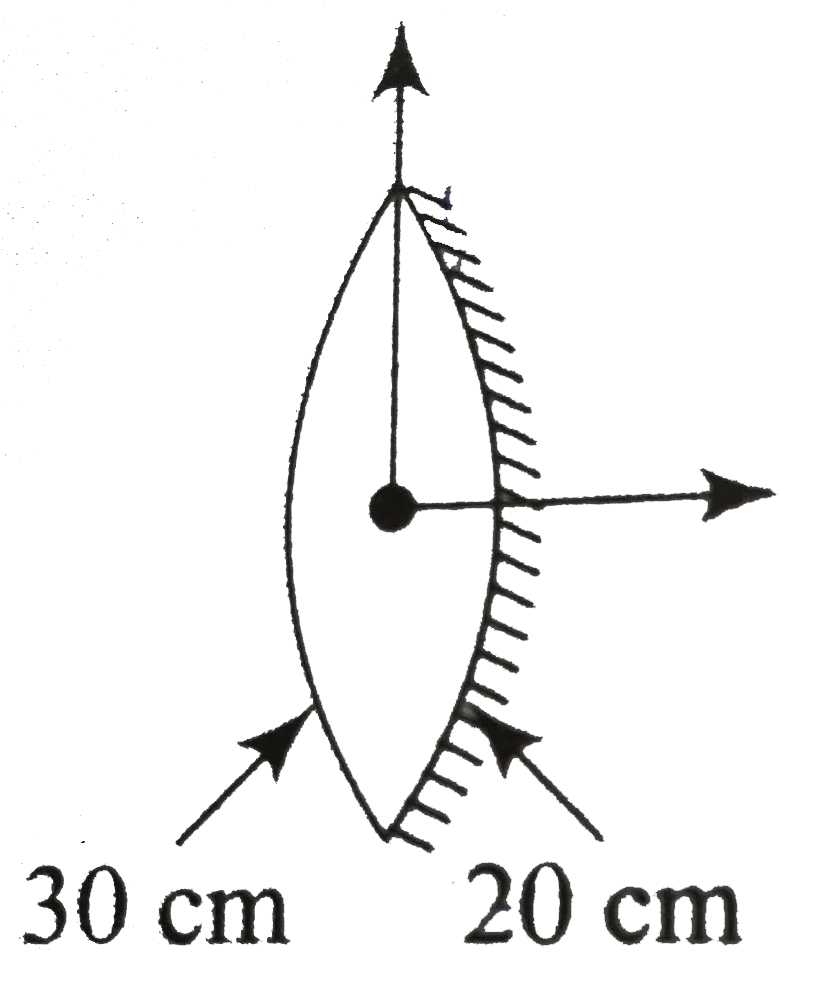The convex side of a thin concavo-convex lens of glass of refractive index 1.5 has a radius of curvature of 20cm. The concave surface has a radius of curvature of 60cm. What is the focal length of the lens? The convex side is silvered and placed on a horizontal surface. What is the effective focal length of the silvered lens? The concave part is filled with water with refractive index 1.33. What is the effective focal length of the combined glass and water lens? If the convex side is silvered what is the new effective focal length of the silvered compound lens?
To solve the problem step by step, we will break it down into parts as follows:
Step 1: Calculate the Focal Length of the Concavo-Convex Lens
The formula for the focal length F of a lens made of a material with refractive index n and having radii of curvature R1 and R2 is given by:
1F=(n−1)(1R1−1R2)
Where:
- n=1.5 (refractive index of glass)
- R1=+20cm (convex surface, positive)
- R2=−60cm (concave surface, negative)
Substituting the values into the formula:
1F=(1.5−1)(120−1−60)
Calculating the right-hand side:
1F=0.5(120+160)
Finding a common denominator (60):
1F=0.5(360+160)=0.5(460)=0.5⋅115=130
Thus, the focal length F is:
F=30cm
Step 2: Effective Focal Length of the Silvered Lens
When the convex side of the lens is silvered, it acts as a concave mirror. The focal length of a mirror is given by:
Fm=−R2
Where R is the radius of curvature of the mirror. For the convex side:
Fm=−202=−10cm
Now, the effective focal length Feff of the combination of the lens and the mirror is given by:
1Feff=1F+1Fm
Substituting the values:
1Feff=130+1−10
Finding a common denominator (30):
1Feff=130−330=−230=−115
Thus, the effective focal length Feff is:
Feff=−15cm
Step 3: Effective Focal Length of the Combined Glass and Water Lens
Now, we need to find the effective focal length when the concave part is filled with water (refractive index nw=1.33).
The focal length of the water-filled part Fw can be calculated using the same formula:
1Fw=(nw−1)(1R2)
Substituting the values:
1Fw=(1.33−1)(1−60)=0.33⋅(−160)=−0.3360
Calculating Fw:
Fw=−600.33≈−181.82cm
Now, we can find the effective focal length of the combined lens system:
1Fcombined=1F+1Fw
Substituting the values:
1Fcombined=130+1−181.82
Finding a common denominator (approximately 181.82):
1Fcombined=6.06181.82−1181.82=5.06181.82
Calculating Fcombined:
Fcombined≈181.825.06≈35.94cm
Step 4: New Effective Focal Length of the Silvered Compound Lens
If the convex side is silvered again, we need to find the effective focal length of the new compound lens. The effective focal length can be calculated as:
1Fnew=1Fcombined+1Fm
Substituting the values:
1Fnew=135.94+1−10
Finding a common denominator (approximately 35.94):
1Fnew=135.94−3.59435.94=−2.59435.94
Calculating Fnew:
Fnew≈−35.942.594≈−13.87cm
Summary of Results:
1. Focal length of the lens F=30cm
2. Effective focal length of the silvered lens Feff=−15cm
3. Effective focal length of the combined glass and water lens Fcombined≈35.94cm
4. New effective focal length of the silvered compound lens Fnew≈−13.87cm
- n=1.5 (refractive index of glass)
- R1=+20cm (convex surface, positive)
- R2=−60cm (concave surface, negative)
1. Focal length of the lens F=30cm
2. Effective focal length of the silvered lens Feff=−15cm
3. Effective focal length of the combined glass and water lens Fcombined≈35.94cm
4. New effective focal length of the silvered compound lens Fnew≈−13.87cm
Topper's Solved these Questions
- BOOK - CENGAGE PHYSICS ENGLISHCHAPTER - GEOMETRICAL OPTICSEXERCISE - Subjective26videos
GEOMETRICAL OPTICS
- BOOK - CENGAGE PHYSICS ENGLISHCHAPTER - GEOMETRICAL OPTICSEXERCISE - Single Correct221videos
GEOMETRICAL OPTICS
- BOOK - CENGAGE PHYSICS ENGLISHCHAPTER - GEOMETRICAL OPTICSEXERCISE - Exercise1.615videos
GEOMETRICAL OPTICS
- BOOK - CENGAGE PHYSICS ENGLISHCHAPTER - ELECTRON,PHONTS,PHOTOELECTRIC EFFECT & X-RAYSEXERCISE - dpp 3.315videos
ELECTRON,PHONTS,PHOTOELECTRIC EFFECT & X-RAYS
- BOOK - CENGAGE PHYSICS ENGLISHCHAPTER - HEATING EFFECT OF CURRENTEXERCISE - Thermal Power in Resistance Connected in Circuit27videos
HEATING EFFECT OF CURRENT
Similar Questions
Knowledge Check
- Question 1 - Select One
A double convex lens is made of glass of refractive index 1.55 with both faces of same radius of curvature. Find the radius of curvature required, if focal length is 20cm.
A11cmB22cmC7cmD6cm
The convex surface of a thin concave-convex lens of glass of refractive index 1.5 has a radius of curvature 20 cm. The concave surface has a radius of curvature 60 cm. The convex side is silvered and placed on a horizontal surface as shown in figure. (a) Where should a pin be placed on the axis so that its image is formed at the same place ? (b) If the concave part is filled with water (mu = 4/3), find the distance through which the pin should be moved so that the image of the pin again coincides with the pin.
 View Solution
View SolutionA concavo-convex lens is made of glass of refractive index 1.5. The radii of curvature of its two surfaces are 30cm and 50cm. Its focal length when placed in a liquid of refractive index 1.4 is
View SolutionA plano-concave lens is made of glass of refractive index 1.5 and the radius of curvature of its curved face is 100 cm. What is the power of the lens?
View SolutionThe concave and convex surface of a thin concavo-convex lens of refractive index 1.5 has radius of curvature 50 cm and 10 cm respectively. The concave side is slivered then if the equivalent focal length of the silvered lends is −5xcm then find x.
View SolutionA double convex lens is made of glass of refractive index 1.55 with both faces of same radius of curvature. Find the radius of curvature required, if focal length is 20cm.
View SolutionA double convex lens is made of glass of refractive index 1.55 with both faces of same radius of curvature. Find the radius of curvature required, if focal length is 20cm.
View SolutionA biconvex lens is made of glass with refractive index 1.5 and has radii of curvature 20 cm and 30 cm. If the 20 cm surface is silvered, what is the effective focal length of the mirror formed?
 View Solution
View Solution
